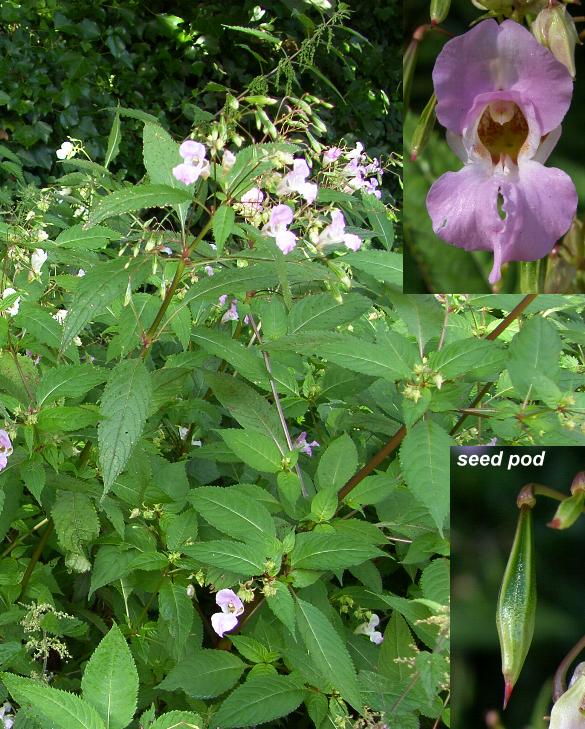Himalayan BalsamScientific Name: Impatiens glandulifera |
A large succulent, annual introduced in 1839 to Kew Gardens as a greenhouse plant, it escaped to the wild, now naturalised in the British Isles and many other countries - it is very invasive and should be removed when found. It is in the same genera as the colourful, bedding Impatiens or Busy-lizzies, but grows much taller - up to 2 metres high. Preferred sites are moist areas, usually along river banks, but it colonises many other areas. Dense stands suffocate other plants so when it dies away in the winter, river banks are left bare and more liable to erosion - this can block drainage systems and the silting of the water damages invertebrates and fish.
The sap can be used to sooth the rash caused by Poison Ivy and the stems can be eaten after boiling. A yellow dye can be extracted from the whole plant.
The hollow, succulent stems have a purple tinge and are smooth or glabrous. The serrated, pointed leaves are arranged in pairs, or three to a node; they are mid green and about 12 to 16cm long.
The flowers vary from pale pink to purple and appear from June to October. The shape resembles an old-style, English policeman's helmet, leading to one of the common names. They produce copious amounts of nectar and are thought to draw pollinating insects in preference to native plants so reducing pollination of the latter.
A single plant can set about 800 seeds, 12 to 14 weeks after flowering. The seed capsules react to the slightest disturbance, causing the five segments to split along their length, then curl up and twist explosively, projecting the contents up to 7 metres away. (This "impatient" release of the seed gives it its approved name, Impatiens.)
The black, spherical seeds are about 2 to 3mm across and remain viable for about 2 years, requiring cold stratification for germination which occurs in February or March. They are buoyant and can travel along waterways to infest new areas, even germinating under water.
Purchasing the seeds will be banned from 2018.
The main aim in controlling this weed is to prevent it setting seed. The shallow roots make it easily uprooted and cutting below the lowest node or at soil level should prevent it from resprouting. Cattle and sheep graze and trample the topgrowth.
By visiting its native habitat various invertebrates and diseases that damage the plants have been investigated. A rust fungus that weakens it has been researched and found to be specific to it so should not attack another species. The spores are sprayed on the undersides of the leaves and the resulting rust infection greatly reduces the vigour of the plants. Native plants will be able to compete with it as the disease becomes widespread.
Glyphosate kills the plant, but must be applied at an early stage well before flowering.
2,4-D amine is selective so any underlying grass should survive application, thus improving soil stability and a dense cover of grass will inhibit further germination. Care should be taken if using a herbicide close to waterways to prevent damage to aquatic life.
